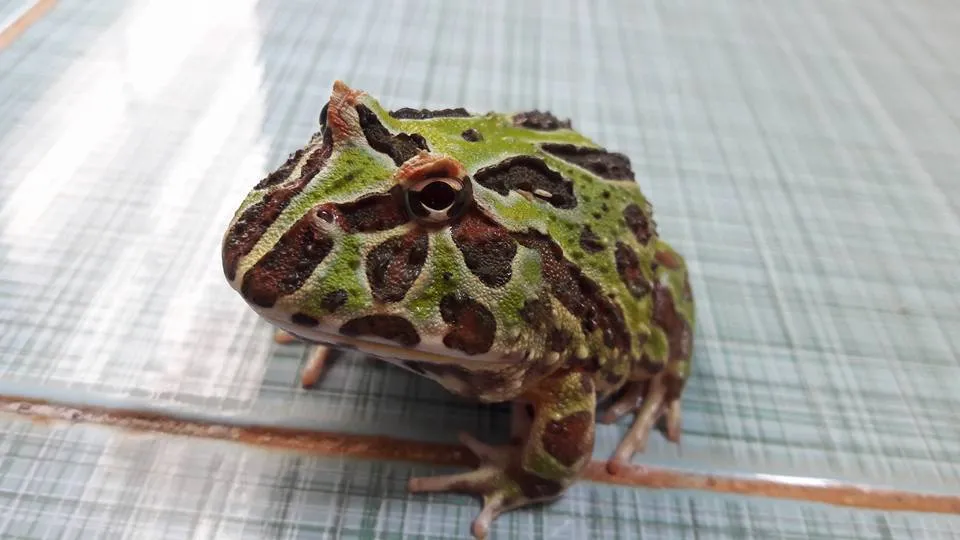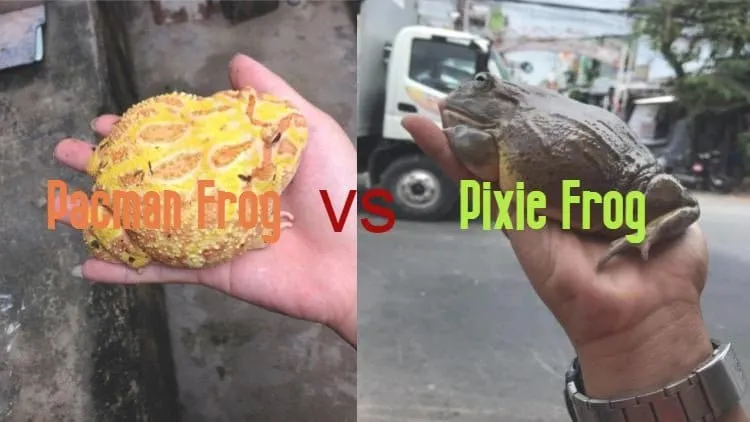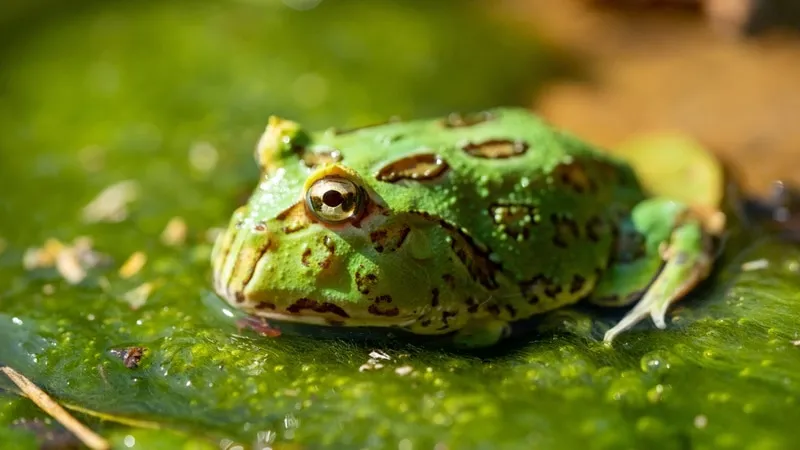Pacman Frog vs Tarantula: Introduction
The natural world is full of captivating battles, and few are as intriguing as the potential clash between a Pacman frog and a tarantula. These creatures, from vastly different worlds, present a fascinating scenario. One is a voracious amphibian predator, the other a stealthy arachnid hunter. This article delves into a detailed analysis to determine who would likely emerge victorious in a direct confrontation. We will examine their unique characteristics, hunting strategies, and combat capabilities to predict the outcome of this epic battle of the wild. The Pacman frog, known for its large mouth and ambush tactics, meets the tarantula, famed for its venom and predatory prowess. Let’s begin!
Pacman Frog: The Amphibian Predator
The Pacman frog, scientifically known as Ceratophrys is a popular pet known for its distinctive round shape and large mouth, resembling the video game character Pac-Man. They are native to South America and are primarily ambush predators. Their camouflage skills allow them to blend seamlessly with their environment, waiting patiently for unsuspecting prey to wander close. Their powerful jaws and aggressive feeding behavior make them formidable hunters. They are also known for their voracious appetites, consuming anything from insects and small rodents to other frogs, and even smaller snakes. Their behavior shows a primal instinct to capture and consume anything within reach, which makes them fascinating subjects of study in their behavior.
Pacman Frog Habitat and Diet

Pacman frogs thrive in humid environments such as rainforests, grasslands, and swamps. Their natural habitat provides the necessary moisture and temperature for their survival. They often bury themselves in the substrate, waiting for prey. Their diet is quite diverse, including insects like crickets and mealworms, as well as small vertebrates. In captivity, they are fed a variety of insects, and occasionally, small vertebrates such as feeder mice. The frog’s hunting strategy involves lying in wait, camouflaged, and ambushing anything that comes within striking distance. Their diet in the wild is largely dictated by what’s available, including anything they can overpower and swallow whole, illustrating their opportunistic feeding style.
Pacman Frog Size and Strength
Pacman frogs can grow up to 8 inches in length, with females typically being larger than males. Their size contributes significantly to their hunting capabilities. Their most potent asset is their powerful bite. The force they can generate is considerable, capable of crushing the exoskeletons of insects and even causing injury to larger animals. The strength of their jaws combined with their ambush tactic, makes them dangerous predators, even to creatures that might seem more imposing at first glance. Their robust build and powerful muscles give them an advantage in combat. Considering their size and strength, they can be quite formidable hunters in their natural environment, making them one of the more impressive amphibians.
Tarantula: The Arachnid Hunter
Tarantulas, members of the Theraphosidae family, are large, hairy spiders found in tropical and subtropical regions worldwide. These arachnids are known for their diverse colors and sizes. Unlike many spiders, tarantulas primarily hunt on the ground, utilizing their fangs to inject venom into their prey. This venom is used to paralyze and begin the process of digestion before consumption. They are nocturnal hunters, using their senses to detect movement and vibration. They are capable predators with a range of survival adaptations. Their appearance can be intimidating, but their behaviors are incredibly fascinating. The life of a tarantula is complex, and their role in the ecosystem is vital.
Tarantula Habitat and Hunting Strategy

Tarantulas live in a variety of habitats, from burrows in the ground to crevices in trees. They are typically solitary creatures, only coming together to mate. Their hunting strategy is based on ambush and venom. They may wait in ambush near the entrance to their burrow or actively hunt. Tarantulas use their fangs to inject venom, which immobilizes their prey. They then use digestive enzymes to liquefy the insides of their prey before consuming them. Their diet consists of insects, other arthropods, and occasionally small vertebrates. Their hunting strategy is highly specialized and efficient, making them successful predators. These spiders are well-equipped to capture and consume a wide range of prey items, allowing them to thrive in various environments.
Tarantula Size and Weaponry
Tarantulas range in size, with some species having a leg span of over 10 inches. Their size and the presence of venom are their primary weapons. They use their fangs to inject venom, which can be painful and paralyzing to their prey. They also have urticating hairs on their abdomen, which they can flick at perceived threats as a defense mechanism. These hairs cause intense irritation. Their large size and the potential for painful bites or the irritation from their hairs make them formidable opponents. The combination of venom and physical defenses gives them a significant advantage when confronting potential predators or defending themselves from threats, contributing to their survival.
Pacman Frog vs Tarantula: Head-to-Head Combat Analysis
To determine the likely outcome of a fight between a Pacman frog and a tarantula, it’s important to consider several factors. These include size and reach, offensive capabilities, and defensive capabilities. Each of these elements plays a crucial role in the survival of these two creatures. Analyzing each factor will help us understand which animal has a greater chance of winning the fight. This kind of assessment helps illuminate the strengths and weaknesses of both opponents. This in-depth look provides insight into what each animal brings to the table, adding depth to our comparison and analysis of the potential outcome.
Size and Reach Comparison

The size difference between a Pacman frog and a tarantula can vary depending on the species. Generally, larger tarantulas can be larger than an adult Pacman frog. The tarantula’s leg span gives it a longer reach, allowing it to potentially strike from a distance. The Pacman frog, however, has a compact, powerful build. This means the frog can quickly launch itself at the spider, using its jaws as its primary weapon. However, the spider has an edge in terms of being able to use its fangs to strike, and even its hairs, before the frog can get too close. Depending on the size comparison, one animal may have a clear advantage. Therefore, the size of each specimen must be taken into account.
Offensive Capabilities
The Pacman frog’s primary offensive weapon is its bite, capable of delivering a crushing force. The tarantula uses its fangs and venom, which can paralyze its prey. The tarantula’s venom is particularly effective against insects and can quickly incapacitate smaller animals. The frog, however, can deliver a powerful bite, and has the advantage of being able to swallow its prey whole. The tarantula may have a better initial attack, but the frog’s sheer power makes it a formidable opponent. Both creatures can cause significant damage to each other. The outcome of the fight would likely depend on who can deliver the first, decisive attack, or who can withstand the other’s offensive capabilities longer.
Defensive Capabilities
The Pacman frog relies on its camouflage and ambush tactics for defense. Its skin offers some protection against bites, though it is not invulnerable. The tarantula has multiple defensive mechanisms. It can flick urticating hairs, causing irritation. Its fangs and venom provide a degree of protection as well. The spider’s ability to retreat into burrows or defend itself with hairs gives it added protection. It is worth noting that both animals are capable of withstanding attacks. The frog’s hide can provide a degree of defense, but it is susceptible to injury. The spider has the advantage of being able to retreat and flick hairs, creating distance and time for defense.
Pacman Frog vs Tarantula: Likely Outcome

Predicting the outcome of a fight between a Pacman frog and a tarantula is complex. There are many variables that impact the outcome. The most likely scenario is that the Pacman frog would win. Its powerful jaws and the ability to swallow the tarantula whole give it a significant advantage. The tarantula, however, might be able to inflict a bite before the frog attacks. If the frog fails to land a successful bite, it could become a victim. The result of such a battle depends greatly on who lands the first successful strike, and the size of the combatants. If the frog is significantly larger, the tarantula has a much lower chance of winning, and vice versa.
Factors Influencing the Fight
Several factors can affect the outcome of this battle. The size difference between the frog and the tarantula is critical. The health and condition of both animals are also major considerations. An injured or weak tarantula or Pacman frog would be at a significant disadvantage. The environment also plays a part. If the battle occurs in a confined space, the frog’s advantage in its bite could be more pronounced. If the fight is in a more open area, the tarantula might have space to avoid attacks. Ultimately, a lot of factors contribute to the outcome, and it can be very unpredictable. Understanding these factors can help to determine the likelihood of each scenario.
Expert Predictions
Experts in herpetology and arachnology would likely have varying opinions. Some might argue the tarantula’s venom gives it an edge. Others would place their bets on the frog’s powerful bite and its ability to engulf its prey. The consensus appears to lean towards the Pacman frog as the likely winner, particularly if the frog is of comparable or larger size than the tarantula. However, as with any natural fight, there are too many variables. The outcome could be different each time. It would be fascinating to watch, even though it’s difficult to have a definitive conclusion.
Conclusion: The Ultimate Winner

In the clash of the Pacman frog versus the tarantula, the frog is predicted to be the likely victor. The combination of its ambush tactics, powerful jaws, and ability to swallow its prey whole provides a distinct advantage. While the tarantula has defensive strategies and venom, it may not be enough to overcome the frog’s offensive capabilities. However, each fight would depend on a number of factors. The ultimate winner depends on size, health, and luck. The natural world is filled with these types of dramatic encounters, demonstrating the brutal realities of survival. This battle showcases the raw power of nature and the adaptations that animals have developed to survive.
